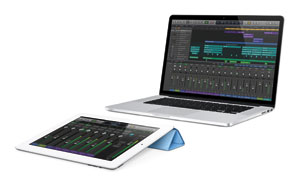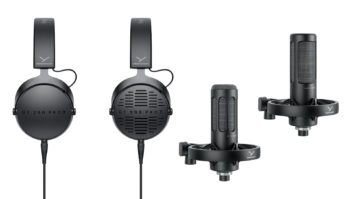
It’s been four long years since Logic Pro 9 launched, and some were beginning to wonder if Apple had abandoned its high-end DAW. Logic has come a long way since its origins on the Atari ST in the 1980s. It gradually evolved into a Mac- and Windows-based MIDI sequencer and eventually into a Mac-only DAW soon after Apple acquired Hamburg-based developer Emagic in 2002. Along the way, Logic’s price has risen and fallen dramatically, while its capabilities have continually skyrocketed.
The newest version is Logic Pro X, and it’s more comprehensive than ever. Unlike the popular perception of Final Cut Pro X, there’s nothing “dumbed down” about it.
The entire package costs the same as the previous upgrade and the same as the discontinued entry-level Logic Express 9.
The initial download from the App Store is 650 MB. You can download as much or as little as you want of the remaining 35 GB of content from within Logic. By default, the content will be installed on your startup drive, so you’ll need plenty of space. Once installed, you can move the largest files, including sampler content, Apple Loops and impulse responses, to a separate hard drive, and then create aliases to link them to your startup.
Layout and Workflow
The first thing you’ll notice when you open Logic Pro X is the GUI overhaul. Although many of its features and functions are identical to previous versions, its layout improves workflow and new functions abound. Much of what appears onscreen—from tracks to knobs to plug-in windows—is much larger without contributing to screen clutter. The transport is in the control bar at the top (as it is in most DAWs), and you can customize which tools appear in the toolbar and what information appears in the display.
To help you learn your way around, enabling Logic Pro’s new Quick Help feature opens a window that identifies anything underneath your pointer. It works just like Ableton Live’s Info View, displaying the function of tools, areas, buttons, knobs, sliders and displays. (I did find plenty of windows that don’t support Quick Help, however.)
Smart Controls let you create an onscreen panel that remotely controls any plug-in or channel strip parameter for the selected track. You can assign any of its controls to any MIDI CC using a learn function. A single knob or button can change several parameters simultaneously.
What Else Is New?
Apple discontinued the audio-editing application Soundtrack Pro almost two years ago, but much of its functionality is built into Logic Pro X. The stereo Audio File Editor window makes it easy to switch between audio displayed in a track and in its associated audio file, so you always have a choice between nondestructive and destructive editing. Control-clicking in the Audio Track window reveals a nice variety of commands for editing, looping, converting, automating and so on.
Regarding new creative tools, MIDI FX delivers nine specialized processors ranging from Modifier, which converts one type of MIDI data to another, to one of the most sophisticated yet easy-to-use arpeggiators I’ve seen. Modulator supplies an LFO and an ADSR generator you can route to any MIDI CC destination. If you’re fluent in Javascript, Scripter lets you write your own MIDI effects, and if you aren’t, it furnishes 27 scripts that perform some very cool tricks like harmonizing and stuttering with MIDI.
Track Stacks allows you to create any number of tracks, group them to function as a single track routed to an aux channel, and then save the entire configuration as a Patch you can recall at any time. Stacking tracks is the easiest way to layer software and hardware synths to respond simultaneously when you play a MIDI keyboard, for example, or to solo, mute, assign effects, or change the level of a group of tracks all at once. Track Stacks is also handy for assigning each drum in a kit to its own track, though you want to collapse them to a single track to save space onscreen.
Logic’s new Flex Pitch feature lets you manipulate audio data to correct and transpose pitch. The software analyzes pitch changes and creates segments you transpose by dragging them up or down. Each segment also has hot zones you can click and drag to fine-tune pitch, vibrato or formant content, and to adjust how quickly and how far a note slides in or out of pitch. Flex Pitch lets you quickly and effectively perform edits that would otherwise require separate pitch-editing software.
Onboard Instruments
For years, Apple’s outstanding suite of software instruments has given Logic Pro an edge over DAWs with less stellar offerings. Alongside top-notch classics like Sculpture and Ultrabeat, Logic Pro X introduces some new plug-ins. All instruments come with an excellent variety of professionally designed presets.
The new Vintage B3 plug-in replaces Logic Pro 9’s EVB3 Tonewheel Organ. It emulates the sound, controls and functionality of a Hammond B-3 with a Leslie. You can specify the organ’s age and condition, along with other parameters that enhance its realism. The plug-in’s look is far superior to its predecessor’s, and all the controls are at least twice as big. Likewise, the much-improved Vintage Electric Piano replaces EVP88 Electric Piano, and Vintage Clav replaces EVD6 Electric Clav. Both have larger and more useful controls that entice you to get in there and tweak.
The all-new Retro Synth lets you switch between four types of synthesis—Analog, Sync, Table and FM. In look, sound and feel, Analog and Sync resemble a polyphonic Minimoog, Table resembles a PPG Wave, and FM resembles a Yamaha DX7. All of them share the same envelopes, effects and other functions; they only differ in their oscillator sections.
Drum Kit Designer is more than just a new instrument plug-in; it’s a collection of sampled drum kits you can customize by specifying the gain, tuning and dampening characteristics of each drum and cymbal. Choose from three kicks and three snares for each stereo kit, and adjust the gain of instruments such as shaker, tambourine and cowbell. Multi-output drum kits give you additional routing and processing options, as well as a much larger selection of drums and cymbals.
Drummer isn’t an instrument, per se, but a type of track that plays drums using what Apple describes as a “virtual session player.” Apple has captured the performances of 15 real drummers playing rock, pop and R&B grooves and converted them to MIDI data. You control the loudness and complexity of the beats and fills by positioning a puck on a 2-dimensional pad. Each virtual player comes with presets that affect the player’s focus on different parts of the kit and specify parameters such as swing, ghost notes and how much it plays behind or ahead of the beat. You can create your own presets, too.
Apple isn’t the first company to develop an iPad app for controlling a DAW via Wi-Fi, but Logic Remote (free) is one of the most comprehensive I’ve seen. Use it to control transport, access tools, perform mixer functions and trigger key commands. Use Smart Controls to adjust a plug-in’s parameters without opening the plug-in. Any movements you make using Logic Remote’s control can be automated in Logic Pro, and Logic Remote’s Touch Instruments function lets you play software instruments remotely on your iPad.
Why Wait?
Working in Logic Pro X is definitely faster than in any previous version. Something about its layout just seems more, um, logical than ever before. The new Logic is so packed with features and functions that I barely have space to even mention latency compensation for plug-ins and external instruments, multiple layers of autosave, comprehensive score editing, 7.1 surround support, and the Pedalboard plug- in’s 35 stompboxes, as well as the ability to import and export AAF, OMF, Open TL, and XML files.
Logic Pro X’s lack of support for 32-bit Audio Units doesn’t mean you’ll have to forego your favorite plug-ins, because Logic Pro 9 can peacefully coexist on the same computer as Logic Pro X, and you can easily import any projects from as far back to version 5 once you’ve bounced any audio tracks that use 32-bit plug-ins.
If you’re looking to replace your studio’s current DAW, Logic Pro X is well worthy of your consideration. If you use a lot of software instruments especially, consider Logic to supplement your current DAW. And if you’re a Logic user wondering if you should upgrade, the answer is definitely yes.
Studio synthesist Geary Yelton is the former senior editor of Electronic Musician.
Product Summary
COMPANY: Apple
PRODUCT: Logic Pro X
WEB:apple.com
PRICE: $199
PROS: Unbelievable bang for the buck. Easy on the eyes. Includes dozens of excellent software instruments and processor plug-ins. Tons of loops and sampler content. Hundreds of mixer channels. 24-bit, 192kHz support.
CONS: Requires Mac OS X 10.8.4 (Mountain Lion) or later. Works only with 64-bit Audio Unit plug-ins.
Try This
Stacking tracks offers new ways of creating splits and layers when you’re working with MIDI instruments and soft-synth plug-ins. To stack any number of synth and sampler tracks, simply Command-click on their headers, select Create Track Stack from the Track menu, and choose Summing Stack. Specify each instrument’s note and velocity range to enable split zones and velocity switching, as you would when programming content for a sampler. When tracks are stacked, you can collapse them so that only a single track appears onscreen, or expand them to make adjustments to each one’s relative level, panning, effects and so on.







